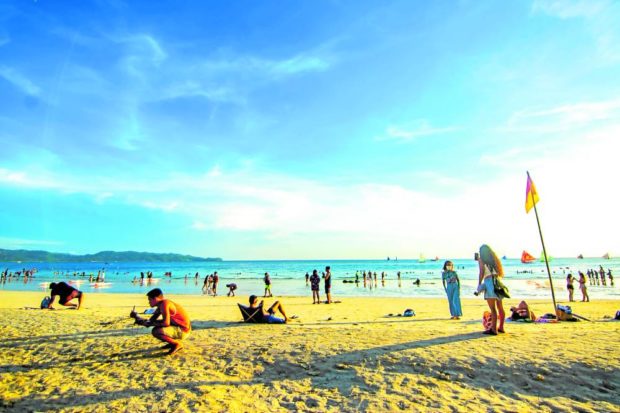
ONCE AGAIN THE LEISURE DESTINATION | Tourists take their spots on the beaches of Boracay Island in this June 2022 photo. (Photo by IAN PAUL CORDERO / Contributor)
ILOILO CITY, Iloilo, Philippines — Boracay Island registered 1.5 million tourists since the start of 2022, with domestic travelers making up the bulk of arrivals into the country’s leading leisure destination, heralding a full comeback nearly three years into the coronavirus pandemic that placed the island’s economy in the brink of collapse.
Latest data released by the Department of Tourism in Western Visayas (DOT 6) showed that as of Nov. 14, the world-famous island in Malay town, Aklan province, has welcomed 1,503,187 visitors, 1.38 million of whom, or 90.23 percent, were from different parts of the country.
The peak of domestic arrivals was seen in the months of May and June when the island recorded 193,298 and 182,508 tourists, respectively.
The island resort logged this year’s lowest number of visitors in January, with 35,799, when travel was still heavily regulated due to COVID-19.
‘Revenge travel’
This year’s January to November arrival figure was only half a million shy of what was recorded in 2019, before the pandemic brought the world economy to its knees, when the island was visited by 2,034,599 domestic and foreign tourists.
Based on the data from the Malay Municipal Tourism Office, only 334,455 tourists visited the island in 2020 and 330,622 in 2021.
DOT-6 Regional Director Cristine Mansinares, in a phone interview on Friday, was optimistic that foreign arrivals on the island would also increase with the loosening of travel restrictions.
“We are looking forward to foreign arrivals rising again because it will take time for the rest of these flights to resume or be reestablished in Western Visayas, Iloilo, and Kalibo [airports]. But we are very hopeful that ‘revenge travel’ in the international market will push through in 2023,” she said.
Cristine Mansinares, Western Visayas regional director of the Department of Tourism (Photo from the Facebook account of Neda-Western Visayas)
Despite the resumption of flights from Incheon International Airport in South Korea to Kalibo International Airport, Panay Island’s major gateway, Mansinares said this has not contributed much to foreign arrivals on the island.
Boracay’s prepandemic visits were dominated by tourists from China, followed by South Korea, Taiwan, United States and Japan.
“Based on our record, some of the foreign tourists who visited lately were already here in the Philippines, so they moved around. Right now, our projection for this year is that domestic [tourism] will continue to propel our tourism industry. We rely on our domestic market as of now,” Mansinares said.
“China, which is one of our top [Boracay] markets, has not resumed outbound leisure travel, except for certain reasons when they are allowed to do so. Our top foreign markets haven’t returned to Boracay,” she added.
Strategies
Mansinares cited three key strategies to improve visits to Boracay and the rest of Western Visayas.
This includes strengthening of local tourism products and services; capacity building with a focus on the Filipino brand of service excellence for tourism front-liners; and close collaboration with local governments and private stakeholders in the implementation of tourism recovery initiatives.